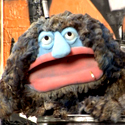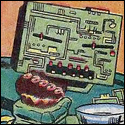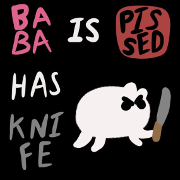|
What is that crackling sound I hear during my prints? I assume it's bad, but I have no idea how to fix it.
|
|
|
|

|
| # ? May 20, 2024 06:07 |
|
kid sinister posted:What is that crackling sound I hear during my prints? I assume it's bad, but I have no idea how to fix it. Moisture in your filament evaporating in the hot end. Itíll cause little voids in your filament. I use a combo dryer box and filament dispenser to dry out my filament as I use it. There are plenty of other methods but I donít recommend using an oven because when I tried it I ruined a whole spool
|
|
|
|
Tiny Timbs posted:Moisture in your filament evaporating in the hot end. Itíll cause little voids in your filament. And all this time I thought it was head crashes... Wouldn't that just get rid of the sound and leave the voids?
|
|
|
|
kid sinister posted:And all this time I thought it was head crashes... Wouldn't that just get rid of the sound and leave the voids? No. The voids are happening because the steam asplodes while the filament is coming out, basically creating string swiss cheese.
|
|
|
|
Yeah your filament is waterlogged for whatever reason. Probably high humidity due to local conditions. Set your oven to lowest and then throw the spool in there for 45 minutes, cool down for 20 min and do two or three cycles like that. Filament heater is better but an oven will work just keep an eye on the temp want to stay in the 120°F range (or whatever) so it doesn't deform and become unusable
|
|
|
|
TerminalSaint posted:Saw this on twitter: So.. this is when you have someone who's got fabrication skills, creativity, and no ability to do engineering. I saw it too. This guy is "I wanna keep my frame cool so it doesn't distort". ... which is not how that works. Also, wants a hot print volume, so they are litterally going to pump the heat out of the printer. *sighs*
|
|
|
|
Nerobro posted:So.. this is when you have someone who's got fabrication skills, creativity, and no ability to do engineering. But what if they hook it to a boiler to bring the frame up to temperature quicker, what about that smartypants? Oh right, it will cook the grease on the rails.
|
|
|
|
deimos posted:No. The voids are happening because the steam asplodes while the filament is coming out, basically creating string swiss cheese. yeah. when water boils into steam, its volume increases by a factor of around 1700. so a literally microscopic droplet of water will pop like a popcorn kernel into a much larger and more significant bubble when it goes through the extruder. this expansion ratio of 1700x is also a big part of why boiler explosions are so dangerous.
|
|
|
|
P1S is hands down the best printer I've ever owned. If you turn off the purge tower and pooping, is there a funky transition between colors? or will that just end up with a spaghetti mess at each transition?
|
|
|
|
If you set flushing to 0 / disable pooping, you'll get an obvious gradient from color A to B, yes. If you're mixing materials, you might get some funky spaghetti. (PLA/PETG, ex.) In extreme cases like black to white, that might tint a huge amount of the layer some shade of grey, or just make the colours look a lot more fuzzy. (You can minimize this by setting the print order to infill-inner-outer, but you'll still be risking some color bleed.) If you disable the prime tower, (It uses 45mm3 filament by default, compared to flushing volumes that are 100-800.) you might get like holes, splotches and wisps whenever it starts a new layer. I like the prime tower because it'll collect any wisps or blobs from the filament swap, before the print head moves on to the print. Once it even caught a poop the nozzle had dragged back onto the print bed.
|
|
|
|
Iím sorry, they call the pooping feature flushing?
|
|
|
|
I made a big mistake. So, we have a GMax2 at work (manufacturer, GCreate, went out of business in august). We thought we'd have some fun and print a big thing because we rarely do that. It's a heated glass bed. What has been our recipe for success for the last couple years for PLA is simple: a bit of glue stick on the glass, then a low heat of like 40-50 degrees just to assist. I did the glue for this big footprint, and it was a bad idea. The part was so stuck that when I attempted to peel it off the cooled bed, the leverage of trying to pry it with the scraper cracked the bed in half. So here I am with a broken bed, and I have prints that desperately need to happen because I'm a fool. I replaced it the next day with a spring steel bed and Buildtak. It's gone mostly OK... I've had to do a lot of re-tuning of our prints to get things to stick properly. Right now, this is the settings for the first layer: >.35mm first layer (used to be .25, typical layer height is .2) >dropped z offset a tiny bit to squish more plastic into the bed (we're honestly a little TOO close in areas now, but it makes the far-away areas work better) >slowed down speed of first layer from 50mm/s to 30mm/s >first layer temperature is now 215 (used to be 205, which is what is used for the rest of the print) >clean the bed real good with isopropyl alcohol I think all of these would typically be enough, but this thing i'm printing - essentially a 90 degree arc about 1" wide, 1" tall, and 12" radius, really likes to begin to peel up on the ends about 2 hours into the print. Printing with a brim has mostly fixed this. I'm at "good enough to get us through the next week" but need to consider what to do to make things better. What it appears to be while I'm watching the first layer is that the bed is really bumpy. I've reapplied the bed to get it much smoother - no bubbles - but I'm still seeing big variations in the first layer. We have a BLTouch giving us a decent mesh, but I think the variations are too big for it to cover. (For reference, the grid is maybe about 2" between each point, bilinear) I'm wondering if it has to do with the stackup of the bed. The stackup, top-down: -Buildtak sheet on spring steel -magnetic sticky sheet -1/4" aluminum sheet substrate mounted to frame I did the aluminum substrate because I needed a big plate to mount the magnetic sheet to that I could quickly get in place. I knew we had it, CNC department already had some actively being cut, I assumed it would be somewhat even, and we could get it fastened on the frame without issue. Are variations in that enough to be the source of my issue - Would it be better to replace it with acrylic or glass? My figuring was the spring steel and magnetic sheet would probably be flat/thick/rigid enough themselves to cancel out anything that major on the surface.
|
|
|
|
Fanged Lawn Wormy posted:Adhesion issues You only mentioned cleaning the surface with isopropyl. Try some dish soap first to make sure any grease is dealt with?
|
|
|
|
Normal aluminum plate is comically not-flat and is probably your issue. Cast aluminum tooling plate is very flat and behaves fairly well when heated, but not until you're in the > 3/8" thick realm and that's going to be excessive for a bed slinger. I think going back to glass would be the easiest solution.
|
|
|
|
GMax2 runs a standard mainboard from what I can find. Maybe get another board and klipperize it so you can run a bed mesh and find out exactly how warped your bed is. Bed mesh can help but for really badly warped beds it's not gonna be enough.
|
|
|
|
SubNat posted:If you set flushing to 0 / disable pooping, you'll get an obvious gradient from color A to B, yes. If you're mixing materials, you might get some funky spaghetti. (PLA/PETG, ex.) Thanks, gonna try it. For the specific print, I think it might look cool.
|
|
|
|
Hypnolobster posted:Normal aluminum plate is comically not-flat and is probably your issue. Cast aluminum tooling plate is very flat and behaves fairly well when heated, but not until you're in the > 3/8" thick realm and that's going to be excessive for a bed slinger. I think going back to glass would be the easiest solution. The switchwire seems to throw around a 6mm plate pretty well. Fanged Lawn Wormy posted:I made a big mistake.*snip* Oh. Boy. Lets start with how to save your butt. Go get a pack of aluminum foil, or aluminum tape, take your printer back to the CNC department, and you can use aluminum foil shims under the magnetic bed to flatten the bed. Then, when you go to print, be hotter. 60deg bed is a good idea. And if that's not enough, it might be time for a box, to keep the whole thing warm enough to not play shrinkydink with your bed. Also, to much squish is worse than to little squish. Mouse ears are better than brim. And finally, make sure it's doing the bltouch probe while the bed is hot. Worst comes to worst, printing on a raft isn't a sin. Also, if it gets you through the emergency, a sheet of normal glass is fairly cheap. Right, that should get your print working, so lets get to the infodump part of the reply. Rolled aluminum plate, isn't the good stuff high end printers use. Rolled plate has amazing stresses built in. The stuff you find on a Voron, or other home made "good" printer, is cast and milled aluminum plate. Literally called "tooling plate", because it's flat enough to be used in making tooling. Flat beds are nice. Flat beds aren't necessary. If you actually need a flat part, print a generous raft. Raft side faces on prints aren't... perfect.. but often are better than top layers? I've printed on beds with a 1.5mm slope from one side to the other with a deep enough raft. Heating and cooling of rolled plate is going to make it move, a lot. Heated beds, in general, move a lot from cold to hot. 40 or 50c is really not enough to make for good adhesion. Peeling up comes from the plastic getting smaller, so warmer is better right up until you start having layers not form right. I generally run 60c. Since we're dealing with shrinkage. Putting up some cardboard walls wouldn't be a bad idea. Drafts can cause some real wacky stresses on things, so getting rid of those is going to help. Also, keeping the part warmer will reduce how much force it's imparting to peel up. The magnetic spring steel plates, don't provide any flatness. Glass beds.. can, and do. As much as I hate glass beds, I think a reason they stick around is a sheet of glass is cheaper than a good bed, especially as sizes get larger. So, if I had a printer the size of yours. I'd set the printer to a single touch level to start. Then I'd tram the bed as best I can with the leveling wheels. Then I'd print a single layer thick print the size of the bed. You can use that to judge the wavyness of the bed. Then I'd use aluminum to shim the bed into shape. Then I'd re-engage the bltouch and have it try again. Why did you go with BulidTak instead of PEI?
|
|
|
|
Here4DaGangBang posted:You only mentioned cleaning the surface with isopropyl. Try some dish soap first to make sure any grease is dealt with? Hm. It's fresh from the box, but there's always the chance something on my hands didn't help. deimos posted:GMax2 runs a standard mainboard from what I can find. Maybe get another board and klipperize it so you can run a bed mesh and find out exactly how warped your bed is. Bed mesh can help but for really badly warped beds it's not gonna be enough. Hypnolobster posted:Normal aluminum plate is comically not-flat and is probably your issue. Cast aluminum tooling plate is very flat and behaves fairly well when heated, but not until you're in the > 3/8" thick realm and that's going to be excessive for a bed slinger. I think going back to glass would be the easiest solution. Nerobro posted:Lets start with how to save your butt. [snip] All interesting, and appreciated. Mouse ears are better than brim, huh? I almost tried that then changed to brim at the last second. One thing, as noted above, I am currently unheated. Basically it was the easiest/fastest way to get back in business without to much fuss. The original bed was held in with some stand-off like clips that supported it above a metal frame that has all these bolts and whatnot. We milled a plate that had grooves cut to go around all that so I could just slap it directly on the bed. I thought about using acrylic (original GMax used acyrlic for unheated option, I found that info AFTER I had the aluminum milled). The problem is, the clips are designed for 1/8", and that would definitely bow at 18x18. We only really stock up to 1/4" in our shop, and I didn't want to redesign clips, plus our other printer was occupied. On top of that, I've had accuracy issues with out team that typically runs the CNC for plastics, and they are swamped with other work at the moment. Metal CNC guy is really nice, really fast, and had time to help. I think my next move is to get some glass to re-do this. The original glass was 1/8" with the heating pad stuck on the back and insulated a bit with some foil stuff. I should be able to source some glass locally (might even have scraps in our shop, but they are probably tempered. I know how to cut glass, but I can't cut tempered obviously). Again, I don't know if I'll be able to peel and re-stick the old heating element. Finding one the same size off-the-shelf has been a challenge during cursory research... I could order custom, but I'd really rather not. If I can do this without a heated bed, that'd be ideal. Our office is fairly temperature stable... and it'll get warmer here in the winter soon, which should help. Finally - I did BuildTak because they have a kit pre-made for this printer. I could order it overnight and be installing it by noon the following day. I struggled to find vendors that carried a bed even close to the correct size, let alone able to ship it quickly. Honestly, I also didn't think about the Buildtak kit requiring you to already have a printing bed already. Obvious in retrospect, but it made the day-of a bit panicky when I realized I had more work to do. Time was critical - these prints are for a job that I'm installing next week. I prefer to print these individually (in case of disaster), and each part takes 12 hours to print. I thought I'd have a final design sooner, but there were tons of tiny tweaks I had to figure out when I started putting them together with the other shop-built parts. The first successful part came out this morning, with one minor flaw that doesn't matter mechanically or aesthetically. Thank you all so much for weighing in. FrankenPrinter will continue to provide food for the thread, I'm sure. Fanged Lawn Wormy fucked around with this message at 16:56 on Sep 29, 2023 |
|
|
|
Fanged Lawn Wormy posted:Hm. It's fresh from the box, but there's always the chance something on my hands didn't help. Fresh from the box doesn't mean folks in the factory/shipping department were wearing gloves, I'd wash any plate immediately before first use.
|
|
|
|
 I'm not too bad at this estimating remaining filament thing
|
|
|
|
What are the little clips you have on your steppers?
|
|
|
|
Mass dampeners
|
|
|
|
Bambu users - anyone else have an issue with wifi after this week's firmware update? One of my P1S units now has a really spotty connection for some reason :/ I did a factory reset and all that, same issue.. Next step will be rolling back to the previous firmware, but just wondering if anyone else has experienced this before I start trying anything silly
|
|
|
|
Sockser posted:What are the little clips you have on your steppers? One is to help with strain on the X axis motor, the other is to keep the ones on the extruder clipped out of the way I lost a few pieces of the Prusa kit over the 2ish years I built it like the fabric cable sleeves so want to add whatever I can to ease any potential stress on the cables
|
|
|
|
Macichne Leainig posted:One is to help with strain on the X axis motor, the other is to keep the ones on the extruder clipped out of the way I need you to clarify how this works and provide better photos please. What sort of strain is the X motor taking? Deviant fucked around with this message at 21:10 on Sep 29, 2023 |
|
|
|
Snackmar posted:Bambu users - anyone else have an issue with wifi after this week's firmware update? One of my P1S units now has a really spotty connection for some reason :/ Yep, I sure do. Pain in the rear end, I've been rebooting when it happens which seems to fix it. I'm generally happy with my Bambu stuff but they're honestly a bit too "move fast, break (my) things" for my tastes.
|
|
|
|
I missed it last page, but for everyone getting into CAD, we have a thread: https://forums.somethingawful.com/showthread.php?threadid=3962532&perpage=40&pagenumber=45&noseen=1 My advice to folks there and here and everywhere is to start with Onshape. No install required, itís in your browser, and the elearning is *excellent*. Virtually all modern 3D CAD systems work with the same fundamental workflow (sketch > feature) even with the same features (extrude, revolve, sweep, loft). Onshape just do a really good job of explaining the fundamentals and almost every video is 2 minutes long. University of YouTube is hot garbage for Fusion 360 nearly invariably. Best practices are not followed or understood and people wonder why they have horrendous performance on their simple parts.
|
|
|
|
Not sure if this is real or not: https://x.com/3DPBelgian/status/1707523533952192655?s=20
|
|
|
|
Deviant posted:I need you to clarify how this works and provide better photos please. What sort of strain is the X motor taking? Itís literally a piece of plastic that guides the cables coming out of the X axis so they donít get bent in odd ways. Nothing more fancy than that
|
|
|
|
Listerine posted:Not sure if this is real or not: Someone else had a leaked video. Really just looks like a X1 geared more towards the high-temp technical filaments that demand a heated enclosure too. The hotend looked like the X1 type, so not a X1.1 or anything like that. What kind of filament needs 320C anyway? Every all-metal hotend claims they can do 300C, after all.
|
|
|
|
SubNat posted:Someone else had a leaked video. There's nothing really compelling in that leak for the average person I don't think. I do like the idea of an ethernet jack since I don't have wifi options where I'm printing though. And since my supervisor saw the output from the X1-C and is now talking about getting 2-3 more, I'd probably wait a couple months just for that convenience- if the price point doesn't jump ridiculously.
|
|
|
|
Listerine posted:Not sure if this is real or not: Day 1 purchase if true, nylon gets weird on a vendor by vendor basis, and electrostatic discharge filaments are usually p pricey and in weird materials.
|
|
|
|
Do you guys have any tips on how to fix excessive stringiness?
|
|
|
|
It would help if you talked about what filament it was and what temps your running at.
|
|
|
|
tater_salad posted:It would help if you talked about what filament it was and what temps your running at. PLA+ Light Blue inland/microcenter brand. I did a print at 225C and the same one at 215C and got basically the same amount of stringiness. The problem has been slowly getting worse over the last month or two, regardless of whether I'm using the PLA Dual Color Silk 3D Gold-Purple or the true red or black or white or w/e (all the same brand). I changed the nozzle yesterday and no difference. Retraction is turned on in my default cura settings, though I haven't done any tuning yet. From basic googling I think what I need to do is try tuning that, but I wish I knew what I was compensating for. It's really annoying as I've gotten almost perfect with everything else - bed adhesion is mostly great (and when it's not I know how to add a brim or raft as needed), my z-offset is great, etc etc, but now everything has hair. Which is fine when I'm doing a pinboard as I just trim it off the feet, but not fine when I'm trying to print a cute cat bowl as a gift. The one other thing I can think of is that my filament is now too humid, but I genuinely have no idea how to check that. Everything is stored in the open air downstairs, which is a room with doors to the outside and upstairs and there's airflow basically. And it's been raining all week, but - agh. Help!
|
|
|
|
For PLA, use wire cutters to snip about 2 inches off the end of the roll. Take that small piece and try to make a 90 degree bend in it. If it snaps almost immediately, it's waterlogged and needs to be dried. It should be able to bend around 60-70 degrees without breaking if it's normal. Basically, PLA gets really brittle when it's absorbed too much water.
|
|
|
|
StrixNebulosa posted:PLA+ Light Blue inland/microcenter brand. I did a print at 225C and the same one at 215C and got basically the same amount of stringiness. What's the lower bound temp listed for that PLA+? Just in the last page or two I fought through extensive stringiness with Elegoo PLA+, and ended up with it printing really nicely at 210. I can dig up my retraction settings as well (for an Ender 3 Pro.) Edit: I'm printing it at 210/60 with retraction at 5mm, 45 mm/s. I had started printing it too cold (at 200) and it was gloopy and stringy. After that I overcompensated temp-wise and was printing it too hot, and I think I was close to the melting temp for my bowden tube and that was causing the filament to drag because I had a number of clogging issues. I replaced the nozzle and the bowden tube, dialed it back to 210, and it's been printing great since then. I should have just printed a temp tower from the start, but... I didn't. armorer fucked around with this message at 03:22 on Sep 30, 2023 |
|
|
|
 Okay itís definitely not waterlogged, woo! The temp bound on this is 205-225, so trying 205 now. Please be an easy fix please pleaseÖ The bowls from before, after I took a bit removing strings:  If I can print a clean one I will make a family member really happy.
|
|
|
|
Also, sincerely, thank you for the help. I was getting really frustrated with this. Even if itís not an easy fix (printing the next bowl will take an hour so fingers crossed!) I still super appreciate understanding more about this machine and how to operate it.
|
|
|
|

|
| # ? May 20, 2024 06:07 |
|
StrixNebulosa posted:Also, sincerely, thank you for the help. I was getting really frustrated with this. Even if itís not an easy fix (printing the next bowl will take an hour so fingers crossed!) I still super appreciate understanding more about this machine and how to operate it. The textbook method for finding the best temperature for a given filament is to print a temp tower. You need to find a model and then also figure out how your slicer works for inserting gcode at different layers. It's not hard, but you'll definitely want to look up a youtube vid or two. Basically you then print a tower that starts hotter at the bottom and cools down (typically by 5C) on each "level". They're good for checking bridging and stringing at different temperatures. That will let you see what temp you get the least stringing with, and from there you can pick that temp and start messing with your retraction settings. Depending on your printer, there will be a recommended range for both retraction distance and retraction speed.
|
|
|


































